Oral presentations and abstracts
The on-going missions to small bodies have provided invaluable observations regarding the properties of primitive small body surfaces in different places of the Solar System, their cratering record, as well as the signatures of other processes (e.g. thermal).
The aim of this session is to open the discussion regarding the impact process on small body surfaces, the role of their physical properties and in particular their surface materials. We welcome contributions regarding:
- Studies on the latest advances in observational (e.g. spectroscopy) and experimental techniques (e.g. production of analogue materials) to characterise small bodies and their surface materials.
- Studies on laboratory impact experiments and theoretical modelling of impacts; planetary space missions which, by imaging small bodies and other planetary surfaces, allow the investigation of the outcome of collisional events (Rosetta, New Horizons, Dawn, Hayabusa2 and OSIRIS-REx); asteroid families that are consequence of the collisional break-up of their parent bodies; collisions among asteroids of different compositions that can lead to surface contamination and material mixing. Observational and experimental studies on other processes that occur on the surfaces of small bodies such as thermal cycling etc.
Session assets
Introduction Primitive extraterrestrial materials like carbonaceous chondrite matrices and interplanetary dust particles contain tiny dust grains that were formed in the winds of red giant branch, or asymptotic giant branch stars (AGB) and in the ejecta of novae and supernovae (SNe) explosions before the formation of our solar system. Following their formation, these tiny stardust grains of submicron size traversed through the interstellar medium before being incorporated into the cloud of gas and dust that collapsed and created our solar system. Presolar grains survived the high energy processes that created our solar system and, in their isotopic compositions, preserved the fingerprints that are the nucleosynthetic signatures of the parent stellar sources of the grains.1 Correlating isotopic data of individual presolar silicates with microstructural and chemical analyses obtained by (S)TEM, provides a unique opportunity to provide better insights into physiochemical conditions of grain formation in stellar environments, grain alteration in the interstellar and parent body processes and also helps constraining various astrophysical grain condensation models. In this work, isotopic, structural and chemical analysis of nine presolar silicate grains from the CH3/CBb3 chondrite Isheyevo and CR2 chondrite NWA801 are reported. The grains studied here are found within the lithic clasts in Isheyevo and fine grained chondrule rims in NWA801 that have experienced lower amount of parent body alteration and hence the chemical compositions of presolar grains studied here are minimally altered.
Experimental Presolar oxygen anomalous grain search using oxygen isotope imaging was done in-situ using NanoSIMS50 ion microprobe and five grains from AGB and four grains from SNe, were selected for (S)TEM investigations. The TEM lamellas were prepared using a TESCAN LYRA3 FIB-SEM at Curtin University. Structural and chemical analysis of presolar grains were performed by combining high-resolution scanning TEM imaging, spatially-resolved electron energy-loss spectroscopy (EELS) and spatially-resolved energy-dispersive X-ray spectroscopy (EDS) by using a FEI Titan Cubed Themis 60-300 microscope at the University of Cádiz which was operated at 200 kV. EDS quantification was corrected by using a standard reference sample of known composition and density and by taking into account the thickness of the probed area as determined by using low-loss EELS. EELS spectrum images for fine structures (mostly, O-K, Si-L2,3 and Fe-L2,3 edges) analyses were acquired with the monochromator excited allowing an energy resolution of about 0.4 eV. After denoising using principal components analysis and removal of the multiple scattering, we were able to map the heterogeneities related to the Fe oxidation states and to the oxygen local chemical environment. For the chemical mapping of the Fe3+/ ∑Fe ratios, we have used a home-made Python routine based on the determination of the modified white-lines ratio.2 It allowed us to compare the degree of aqueous alteration of the grain with the surrounding rim and matrix grains.
Results TEM and STEM data have revealed a strong heterogeneity and a broad range of structural and chemical compositions of the grains that enabled us to compare the stellar grain condensation environments (e.g. AGB stars and SNe), and suggest widely varying formation conditions for the presolar silicates identified in this study. Only one of the grains originally condensed as an amorphous grain has shown preferential sputtering of Mg, indicating that Mg-rich amorphous grains are not preferentially destroyed. Several grains are found with signatures that represent interstellar, nebular and parent body alteration. An oldhamite-like grain (Figure 1) within a presolar enstatite grain is probably the first observation of an oldhamite grain as a seed grain for the condensation of an enstatite grain in stellar atmospheres. This grain corresponds to a local increase in Mg and a local decrease in Fe with respect to the surrounding matrix. The surface of the grain surface of up to ~40 nm is composed of higher amounts of Ca and S. Below the surface of the grain and on the left side, diffusion streaks rich in Ca can be observed up to the lower boundary of the grain (on about 250 nm). The diffusion of Ca could be related to thermal processes and/or aqueous alterations undergone by the grain. Figure 2 shows typical EELS chemical maps acquired on the same grain. A very thin Fe-rich rim is also seen around the enstatite grain with a Fe3+/ΣFe ratio of about 0.6-0.7. The presence of several spherical nodules of Fe and Ni sulfide can also be highlighted in the matrix around the grain in the EDS and EELS chemical maps (red arrows in Figures 8 and 9). They have a diameter of about 30-45 nm and are similar to GEMS-like materials. Interestingly, they present a core/shell structure All these results, which will be discussed in detail, point out the importance of coordinated isotopic, microstructural and chemical studies of presolar silicates to investigate the processes that may have played a role in shaping our solar system.
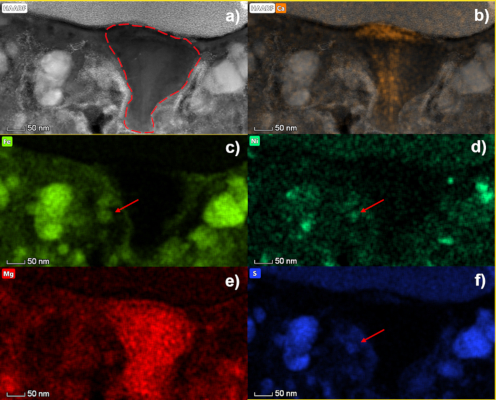
Figure 1. a) STEM-HAADF micrograph of the grain Isheyevo_9. The red dashed lines line highlights the boundary of the grain. b) Superposition of HAADF micrograph and Ca chemical maps derived from EDS analysis. Chemical maps derived from EDS analyses corresponding to c) Fe, d) Ni, e) Mg and f) S elements. The red arrows highlight the presence of GEMS-like materials.
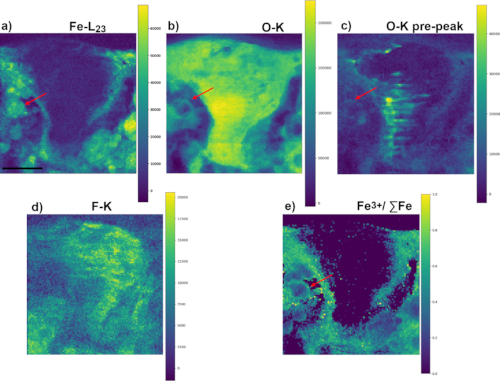
Figure 2. Chemical maps derived from the EELS analysis for the grain Isheyevo_9 and corresponding to a) Fe, b) O, c) the O-K pre-peak, d) F and e) the Fe+3/ΣFe ratio. The black scale bar represents 0.1 µm. The red arrows highlight the presence of GEMS-like materials.
How to cite: Lajaunie, L., Sanghani, M. N., Rickard, W. D. A., Calvino, J. J., Marhas, K. K., and Bizzarro, M.: Combined multi-isotopic and (S)TEM study of pre-solar silicates to probe the solar system’s prenatal history, Europlanet Science Congress 2020, online, 21 Sep–9 Oct 2020, EPSC2020-23, https://doi.org/10.5194/epsc2020-23, 2020.
Sample return missions Hayabusa2 (JAXA) and OSIRIS-REx (NASA) found evidence of hydrated silicates on the surface of C and B-type asteroids Ryugu [1] and Bennu [2]. This detection relied on the study of the Near-IR spectra from remote sensing observations of the asteroids' surfaces. Specifically, the feature is responsible for the OH-stretching mode in hydrated silicates. This feature’s position is related to the composition and structure of minerals [3]. However, atmosphere-less bodies in our Solar System, such as Ryugu and Bennu, are affected by space weathering (SpWe). SpWe might alter the structure and composition of the mineral, thus affecting the IR band profile, depth and position, and complicating the interpretation of remote sensing data [4, 5].
We performed ion bombardment experiments on two serpentines and one saponite, to better understand how SpWe affects the remote sensing of hydrated silicates. These two classes of phyllosilicates are particularly abundant in hydrated carbonaceous chondrites [6], which have been used as standards for the surface materials on primitive asteroids [7, 8]. The ion-bombardment experiments were conducted at room temperature in a vacuum chamber (10-7mbar) on pellets made from our phyllosilicate samples. We used He+ at 40 keV and fluences of 1*1016, 3*1016 and 6*1016 ions/cm2.
We studied the in-situ behaviour of the 2.7 µm band as a function of ion fluence. We found that the evolution of the OH-stretching feature in phyllosilicates depends on the phillosilicate’s nature. For the saponite sample, the feature’s intensity seems to decrease as the band broadens slightly, without changing position. For both serpentine samples, the feature shifts toward longer wavelengths, while peak intensity and width are not strongly affected.
The observed diversity may be explained by the different crystal structure among our two phyllosilicate classes. The observation of a band shift for one of our sample’s classes indicates that space weathering can introduce a bias in the interpretation of NIR remote sensing observations of hydrated minerals. The extent of this shift is detectable by the instruments onboard Hayabusa2 and OSIRIS-REx [11, 12].
References.
[1] Watanabe, S.-I., Tsuda, Y., Yoshikawa, M., et al. 2017, Space Sci Rev, 208, 3; [2] Lauretta, D. S., Balram-Knutson, S. S., Beshore, E., et al. 2017, Space Sci Rev, 212, 925; [3] Besson, G., & Drits, V. A. 1997, Clays Clay Miner, 45, 158; [4] Lantz, C., Brunetto, R., Barucci, M. A., et al. 2017, Icarus, 285, 43; [5] Brunetto, R., Lantz, C., Nakamura, T., et al. 2020, Icarus, 345, 113722; [6] King, A. J., Schofield, P. F., Howard, K. T., & Russell, S. S. 2015, Geochim Cosmochim Acta, 165, 148; [7] Kitazato, K., Milliken, R. E., Iwata, T., et al. 2019, Science, 364, 272; [8] Hamilton, V. E., Simon, A. A., Christensen, P. R., et al. 2019, Nat Astron, 3, 332 ; [9] Mitra, S., Prabhudesai, S. A., Chakrabarty, D., et al. 2013, Phys Rev E Stat Nonlin Soft Matter Phys, 87, 062317 ; [10] Auzende, A.-L. 2003, Evolution des microstructures des serpentinites en contexte convergent: effet du degré de métamorphisme et de la déformation; [11] Iwata, T., Kitazato, K., Abe, M., et al. 2017, Hayabusa2, 317, ; [12] Christensen, P. R., et al. 2019, in 82nd Annual Meeting of The Meteoritical Society, Vol. 2157
How to cite: Rubino, S., Lantz, C., Baklouti, D., Leroux, H., Borondics, F., and Brunetto, R.: NIR remote identification of phyllosilicates and space weathering, Europlanet Science Congress 2020, online, 21 Sep–9 Oct 2020, EPSC2020-126, https://doi.org/10.5194/epsc2020-126, 2020.
Introduction
Shock-induced changes in planetary materials related to impacts or planetary collisions are known to be capable of altering their optical properties. One such example is observed in ordinary chondrite meteorites. The highly shocked silicate-rich ordinary chondrite material is optically darkened and its typical S-complex-like asteroid spectrum is altered toward a darker, featureless spectrum resembling the C/X complex asteroids. Thus, one can hypothesize that a significant portion of the ordinary chondrite material may be hidden within the observed C/X asteroid population.
The exact pressure-temperature conditions of the shock-induced darkening are, however, not well constrained and due to this gap in knowledge, it is not possible to correctly assess the significance of the shock darkening within the asteroid population. In order to address this shortcoming, we experimentally investigate the gradual changes in the chondrite material optical properties together with the associated mineral and textural features as a function of the shock pressure. For this purpose, we use a Chelyabinsk meteorite (LL5 chondrite), which is subjected to a spherical shock experiment. The spherical shock experiment geometry allows for a gradual increase in the shock pressure within a single spherically shaped sample from 15 GPa at its rim toward hundreds of gigapascals in the center.
Results
Four distinct zones were observed with an increasing shock load (Fig. 1). We number the zones in the direction of increasing shock from the outside toward the center as zones I–IV The optical changes in zone I are minimal up to ~50 GPa. In the region of ~50–60 GPa corresponding to zone II, shock darkening occurs due to the troilite melt infusion into silicates. This process abruptly ceases at pressures of ~60 GPa in zone III due to an onset of silicate melting and immiscibility of troilite and silicate melts. Silicate melt coats residual silicate grains and prevents troilite from further penetration into cracks. At pressures higher than ~150 GPa (zone IV), complete recrystallization occurs and is associated with a second-stage shock darkening due to fine troilite-metal eutectic grains.
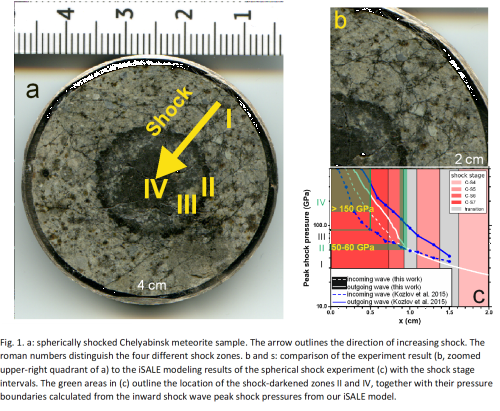
The order of the spectral curves in the UV-VIS-NIR (ultraviolet – visible – near-infrared) region follows the visual brightness in which zone I is the brightest, followed by zones III and II, and zone IV is the darkest one (Fig. 2). The MIR reflectance (Fig. 3) follows the same albedo order as UV-VIS-NIR up to the primary Christiansen feature at 8.7 µm. At higher wavelengths in the Si-O reststrahlen bands region, the reflectance order changes with zones II and III, which are brighter than zones I and IV. The comparison of the powdered sample spectra to the one obtained from the rough saw-cut surface reveals the following trends. The overall reflectance of the powdered sample is an order of magnitude lower compared to the rough surface one. The reststrahlen bands in both samples show similar positions at approximately 9.1, 9.5–9.6, 10.3, 10.8, 11.3, and 11.8–12 µm. They are dominated by olivine with possible presence of orthopyroxene. The amplitudes of the reststrahlen bands are higher in the rough surface sample. The transparency feature at 12.7 µm is only observed in the powdered sample. The primary Christiansen feature at 8.7 µm is more pronounced in the powdered sample, while the secondary one at 15.6 µm is of a low amplitude in both samples.
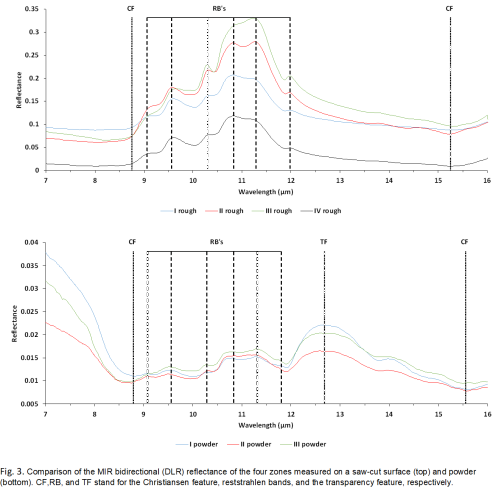
Conclusions
The important finding is the presence of the two distinct shock darkening mechanisms in ordinary chondrite material with characteristic material fabric and distinct pressure regions. These two regions are separated by a pressure interval where no darkening occurs. Thus, the volume of the darkened material produced during asteroid collisions may be somewhat lower than assumed from a continuous darkening process. While the darkening mainly affects the UV-VIS-NIR region and 1 and 2-µm silicate absorption bands, it does not significantly affect the silicate spectral features in the MIR region. These are more affected by material roughness. MIR observations have the potential to identify darkened ordinary chondrite material with an otherwise featureless UV-VIS-NIR spectrum.
How to cite: Kohout, T., Petrova, E., Yakovlev, G., Grokhovsky, V., Penttilä, A., Maturilli, A., Moreau, J.-G., Berzin, S., Wasiljeff, J., Danielko, I., Zamyatin, D., Muftakhetdinova, R., and Heikkilä, M.: Experimental constraints on the ordinary chondrite shock darkening caused by asteroid collisions, Europlanet Science Congress 2020, online, 21 Sep–9 Oct 2020, EPSC2020-128, https://doi.org/10.5194/epsc2020-128, 2020.
The Exolith Lab at The University of Central Florida’s Center for Lunar and Asteroid Surface Science (CLASS) produces high-mineralogical fidelity asteroid and planetary regolith simulants (several are pictured in Figure 1). Regolith simulants are used as analogs in scientific studies and in hardware development and testing for space exploration and in-situ resource utilization (ISRU) efforts. It is crucial that such simulants accurately replicate the mineral, chemical and physical properties of the simulated regoliths. Mineralogical fidelity is the foundation of our approach. For each simulant, we source individual minerals from industrial suppliers to reproduce the mineralogy and bulk chemistry of a reference material. We also control for particle size distribution, crushing the regolith simulant to a power law distribution or sieving to a specified distribution as requested.
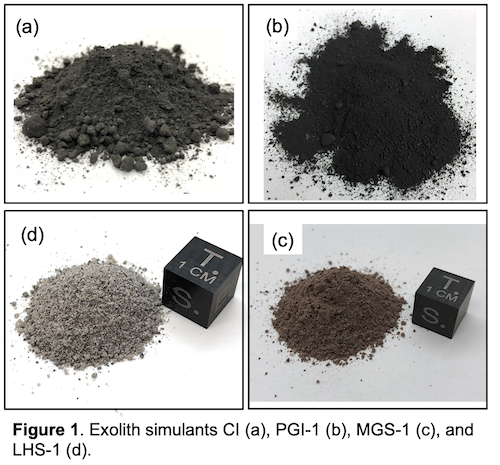
Asteroid and Phobos Simulants
We offer a CI meteorite-based primitive asteroid simulant and have also developed CM and CR based simulants [1]. Volatile-rich asteroids are high-priority targets for ISRU efforts. The CI simulant scores highly in fidelity against reference materials in its mineralogy and bulk chemistry, grain and bulk density, magnetic properties, mechanical cobble strength, and patterns of volatile release [2]. Simulating the organic component of planetary materials is a challenge, as this component contains hazardous polycyclic aromatic hydrocarbons (PAHs). In our simulants, we instead use sub-bituminous coal as the organic component. Sub-bituminous coal has similar aromaticity and chemical composition to PAHs but is significantly less hazardous. Another challenge is sourcing the phyllosilicate components. CM mineralogies in particular contain the Fe-serpentine cronstedtite, which does not occur naturally on Earth in the commercial quantities needed for large scale simulant production. We substitute other phyllosilicates, including Mg-serpentines, opting for the lizardite polymorph rather than hazardous chrysotile.
We have recently developed two Phobos simulants for testing of hardware for the upcoming JAXA Martian Moons eXploration (MMX) mission, which includes a Phobos sample return objective. These simulants are PGI-1 (Phobos Giant Impact), based on the hypothesis that Phobos was formed by a giant impact with Mars, and PCA-1 (Phobos Captured Asteroid), based on the captured asteroid origin hypothesis. The PCA-1 recipe is adapted from our CI asteroid recipe. PGI-1 is CI mixed with a simplified Mars crust and mantle. In addition to our standard tests of bulk chemistry and particle size distribution, we measured the abrasivity, angle of repose, compressive strength, shear strength, cohesion, flowability, and hardness for both Phobos simulants. A paper on these results is in review. This is part of a larger effort to systematically characterize the physical properties of our simulants, including geotechnical properties that are of interest for spacecraft hardware development. We will make these results available to the community in the peer-reviewed literature.
Other Simulants
Exolith Lab also offers the following simulants:
- Lunar Highlands Simulant (LHS-1): Generic highlands soil with a particle size distribution matched to Apollo 16 samples.
- Lunar Mare Simulant (LMS-1): Generic mare soil with a particle size distribution matched to Apollo samples.
- Mars Global Simulant (MGS-1) and variations: Global basaltic Mars soil simulant based on Rocknest soil. Two variants (a sulfate-enriched version, MGS-1S, and a clay-enriched version, MGS-1C) were also developed for water-extraction studies.
- Jezero Delta Simulant (JEZ-1): Developed based on remote sensing of the Jezero delta soils that will be the target of the Mars 2020 Perseverance rover.
- DUST-Y: Physical silicate dust simulant with ~1-10 micron particles. Useful for fine dust mitigation studies.
About Exolith Lab
Exolith Lab is a not for profit extension of CLASS. Our objective is to provide high-mineralogical fidelity, safe planetary regolith simulants to the community at the cost of materials, labor, and facilities. We publicly document the development and recipes for the simulants so that they can serve as an open standard, for use and modification as needed. To order Exolith simulants or for more information, visit our website at https://sciences.ucf.edu/class/exolithlab/. There is also a Planetary Simulant Database available at https://simulantdb.com/.
References
How to cite: Landsman, Z. and Britt, D.: Simulated Asteroid and Planetary Materials at the CLASS Exolith Lab, Europlanet Science Congress 2020, online, 21 Sep–9 Oct 2020, EPSC2020-906, https://doi.org/10.5194/epsc2020-906, 2020.
Keck Time-resolved Spectrophotometry of Temporarily-Captured Minimoon 2020 CD3
Bryce T. Bolin (1,2), Christoffer Fremling (1), Timothy R. Holt (3,4), Matthew J. Hankins (1), Shreya Anand (1), Kishalay De (1), Kunal Deshmukh (5), Mansi M. Kasliwal (1), Alessandro Morbidelli (6), Josiah Purdum(7), Robert Quimby (7,8)
(1) Division of Physics, Mathematics and Astronomy, Caltech, Pasadena, CA 91125, USA (bbolin@caltech.edu)
(2) IPAC, Mail Code 100-22, Caltech, 1200 E. California Blvd., Pasadena, CA 91125, USA
(3) Centre for Astrophysics, University of Southern Queensland, Queensland, Australia
(4) Southwest Research Institute, Department of Space Studies, Boulder, CO. USA.
(5) Dept. of Metallurgical Engineering and Materials Science, Indian Institute of Technology Bombay, Powai, Mumbai-400076, India
(6) Université Côte d’Azur, Observatoire de la Côte d’Azur, CNRS, Laboratoire Lagrange, Boulevard de l’Observatoire, CS 34229, F-06304 Nice cedex 4, France
(7) Dept. of Astronomy, San Diego State University, 5500 Campanile Dr, San Diego, CA 92182, U.S.A.
(8) Kavli Institute for the Physics and Mathematics of the Universe (WPI), The University of Tokyo Institutes for Advanced Study, The University of Tokyo, Kashiwa, Chiba 277-8583, Japan
We report on rotationally-averaged visible spectrophotometry of minimoon 2020 CD3, the second known asteroid to be temporarily gravitationally captured by the Earth-Moon system, taken with Keck I/LRIS between 434 nm and 912 nm in B, g, V, R, I and RG850 bands as it was leaving the Earth-Moon system on 2020 March 23 UTC. We find that the broad-band spectrum of 2020 CD3 most closely resembles a V-type asteroid and some lunar rock samples with a reddish surface with a slope of 18 +/- 3 % between 434 nm and 761 nm corresponding to colors of g-r = 0.62 +/-0.08, r-i = 0.21 +/- 0.06 and an absorption band at ~900 nm corresponding to i-z = -0.54 +/- 0.10 (Isaacson et al. 2011, DeMeo & Carry 2013) as seen in the left panel of Fig. 1. Assuming typical albedos of V-type asteroids, we constrain 2020 CD3's size to be ~1.0 +/- 0.1 m in diameter when combined with our measured H magnitude of 31.74 +/- 0.14. In our time-series data, we detect periodic lightcurve variations corresponding to a rotation period of ~573 s and a Lomb-Scargle false alarm probability of <10-4 (Fig. 2, left panel) with a lightcurve amplitude of ~1 magnitude implying a b/a axial ratio of ~2.5 (Fig. 2, right panel), though this is atypical for meter-scale asteroids which are thought to have rotation periods ~60 s (Bolin et al. 2014). In addition, we refine the orbit of 2020 CD3 with our observations extending the observational arc to 37 days between 2020 February 15 and 2020 March 23 constraining its duration of capture of 2020 CD3 to be ~1.2 years a typical capture lifetime for minimoons (Granvik et al. 2012) as seen in the right panel of Fig. 1. We also constrain the effect of radiation pressure on its orbit with an estimated area-to-mass ratio of 6.9 +/- 2.1 10-4 m2/kg*. Using our diameter and area-to-mass ratio estimates, we calculate a density of 1.6-3.3 g/cm3, broadly compatible with the densities of other small asteroids with densities constrained by radiation pressure measurements (Micheli et al. 2012) and lunar rock (~2.4 g/cm3, Kiefer et al. 2012) somewhat less dense than the typical ~3.5g/cm3 density of V-type asteroids (Carry 2012). We searched for pre-discovery observations of 2020 CD3 in the ZTF archive (Masci et al. 2019) but were unable to locate any positive detections.
References: Bolin et al. 2014, Icarus, 241, 280-297, Carry 2012, PSS, 73, 98-118, DeMeo & Carry 2013, Icarus, 226, 723-741, Kiefer et al. 2012, GRL, 39, 7, Isaacson et al. 2011, M&PS, 46, 228-251, Granvik et al. 2012, Icarus, 218, 262-277, Masci et al. 2019. PASP, 131, 018003, Micheli et al. 2012, NA, 17, 446-452, Rein & Liu. 2012. A&A, 537, A128
*calculated using find_orb by Bill Gray: https://www.projectpluto.com/find_orb.htm
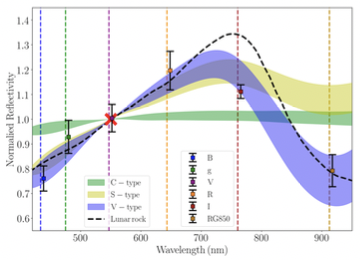
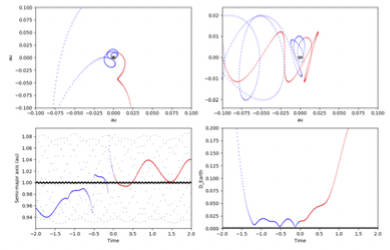
Figure 1. Left panel: reflectance photometric spectrum of 2020 CD3 consisting of B, g, V, R, I and RG850 observations of 2020 CD3 on 2020 March 23 UTC. The 1 σ uncertainties of the normalized reflectivity are indicated by the error bars on the datapoints. The spectrum has been normalized to unity at 550 nm indicated by the red cross. The spectral range of S, V and C-type asteroids from the Bus-DeMeo asteroid taxonomic catalogue (DeMeo et al. 2009) are over-plotted with the V-type spectrum most closely resembling the spectra of 2020 CD3. The average spectrum of coarse bulk lunar rock samples is plotted for reference (Isaacson et al. 2011). Right panel: Orbital evolution of 2020 CD3 based on the orbit determined by publicly available observations of 2020 CD3 available from the Minor Planet Canter dated from 2020 February 15 UTC to our observations taken on 2020 March 23 UTC, performed using REBOUND n-body integrator (Rein & Liu. 2012). Sub-right panel top left: x vs. y Earth-centred co-rotating frame showing the orbital path of 2020 CD3. The blue data points show the orbital path before 2020 March 23 and the red data points show the orbital path after March 23. Sub-right panel top right: x vs. z Earth-centred co-rotating frame showing the orbital path of 2020 CD3. Sub-right panel bottom left: time vs semi-major axis showing the orbital evolution of 2020 CD3. Sub-right panel bottom right: time vs. geocentric distance in au of 2020 CD3.
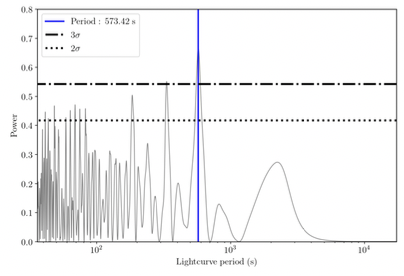
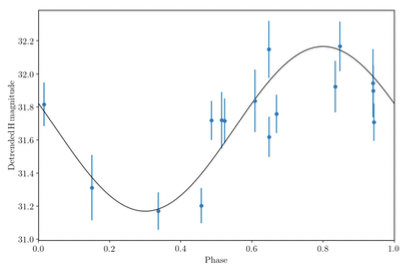
Figure 2. Left panel: Lomb-Scargle periodogram of lightcurve period vs spectral power using the B, g and R lightcurve data from our 2020 March 23 UTC Keck I/LRIS observations. A peak in the power is located at single-peaked rotation period of 573.4 s with a false alarm probability of <10-4. Right panel: phased lightcurve using data converting the B, g and R into H magnitudes corresponding to a single-peak lightcurve period of 574 s and a peak-to-trough amplitude of ~1 magnitude. The 1 σ uncertainties of the magnitudes are indicated by the error bars on the datapoints.
How to cite: Bolin, B., Fremling, C., Holt, T., Hankins, M., Anand, S., De, K., Deshmukh, K., Kasliwal, M., Morbidelli, A., Purdum, J., and Quimby, R.: Keck Time-resolved Spectrophotometry of Temporarily-Captured Minimoon 2020 CD3, Europlanet Science Congress 2020, online, 21 Sep–9 Oct 2020, EPSC2020-489, https://doi.org/10.5194/epsc2020-489, 2020.
OSIRIS-REx is a sample return mission to near-Earth Asteroid (101955) Bennu (Lauretta et al. 2017). The asteroid is spectrally classified as a B-type (Clark et al. 2011), and phyllosilicates similar to those found in carbonaceous chondrites have been detected on its surface (Hamilton et al. 2019). Bennu has a relatively flat (and blue) reflectance spectrum in the 0.4 to 3.7 micron spectral range and has a low albedo of ~4.5% (Golish et al. 2020).
Bennu has a rough and rocky surface. Imaging data from the OSIRIS-REx Camera Suite (OCAMS; Rizk et al. 2018) reveals that boulders in the size range from 1 to 10 meters dominate the surface (Lauretta et al. 2019; DellaGiustina and Emery et al. 2019). Observed boulder textures range from smooth to hummocky and breccia-like (Walsh et al. 2019; DellaGiustina and Emery et al. 2019). The smoother rocks appear to be smaller, brighter, and more angular, while the rougher rocks appear to be larger, darker, and highly textured. Because spectral variations on Bennu are subtle and associated with albedo (Clark et al. 2019), the question arises: Could the observed color variations be due to texture variations alone, or are space-weathering variations required to explain the observations? To isolate the spectral effects of texture on the spectral properties of Bennu, we first simulate Bennu’s spectrum using a two-component mixture, then we check to see whether texture changes in this analog can account for the observed color and albedo trends.
Simulated Bennu Spectral Analog: We synthesized physical mixtures of saponite (SAP105 with ~25 wt.% dolomite) with two forms of carbon: <0.56-micron particles of graphite (GRP102) and <0.021-micron particles of carbon lampblack (LCA101) (Figure 1). These mixtures have the consistency of fine silt and clay mud before they are dried and baked in an oven at ~200˚ Celsius, hence we call them “mudpies”. The spectrum of each mudpie was measured at four textures — textured rock (broken surface), sanded slab, coarse grain, and fine grain — using an ASDI LabSpec 4 Hi-Res in the wavelength range of 0.35–2.5 microns (Figure 1). We also modelled the spectra of intimate mixtures of serpentine with magnetite at the same four textures.
Bennu Spectral Data: We compare the measured and modelled mudpie spectra with Bennu’s reflectance spectra acquired by the OSIRIS-REx Visible and InfraRed Spectrometer (OVIRS, from 0.4 to 2.5 microns; Reuter et al., 2018), and with multispectral image data from the MapCam instrument (at 473, 550, 698, and 847 nm). We selected OVIRS spectra representing the full range of spectral properties of Bennu from the 12:30pm (local solar time) Equatorial Station 3 of the Detailed Survey campaign (Lauretta et al., 2017), at a ground sample distance of ~20 m per spectrum. We selected MapCam 4-point spectra similarly representing a full range of color properties of Bennu from the early afternoon Baseball Diamond Flyby 2 of the Detailed Survey campaign, at ~30 cm per pixel. With these datasets, we can constrain the best possible mudpie analogs for the surface texture and opaque abundance on Bennu. We find that the best analog mudpie for Bennu contains 10% carbon lampblack and 90% saponite.
In Figure 2, we show that the color variations observed on Bennu at 470 and 550 nm can be explained better with our best-analog mudpie ground to grain sizes between 45 and 1000 microns than with mudpies measured at two different surface textures (sanded slab and textured rock). Based on our color trend comparisons with the successful analogs, we conclude that mudpie simulated textures can fully reproduce the range of color trends observed on Bennu, and because texture effects have high-amplitude spectral effects, it is not necessary to invoke space weathering to explain the different color and albedo trends across Bennu’s surface.
However, according to DellaGiustina et al. (in revision), the geologic context of color trends on Bennu implies that space weathering effects may be required to explain the spectral bluing of craters over time. Hence, spectral variations on Bennu could be a combination of texture effects and opaque abundance variations caused by space weathering.
References
Clark, B. E., et al. Asteroid (101955) 1999 RQ36: spectroscopy from 0.4 to 2.4μm and meteorite analogs. Icarus 216, 462-475 (2011).
Clark, B. E., et al. Are the brighter rocks on Bennu products of recent mechanical weathering and therefore less space weathering? EPSC-DPS 2019, Geneva, Switzerland.
DellaGiustina, D. N., Emery, J.P., et al. Properties of rubble-pile asteroid (101955) Bennu from OSIRIS-REx imaging and thermal analysis. Nature Astronomy 3, 341-351https://doi.org/10.1038/s41550-019-0731-1 (2019).
DellaGiustina, D. N., et al. Diverse Color and Reflectance of Asteroid (101955) Bennu. Submitted to Science (in revision).
Golish, D.R., et al., Disk-resolved photometric modeling and properties of asteroid (101955) Bennu. Icarus https://doi.org/10.1016/j.icarus.2020.113724 (2020).
Hamilton, V. E., et al. Evidence for widespread hydrated minerals on asteroid (101955) Bennu. Nature Astronomy https://doi.org/10.1038/s41550-019-0722-2 (2019).
Lauretta, D. S., et al. OSIRIS-REx: sample return from asteroid (101955) Bennu. Space Science Review 212, 925-984 (2017).
Lauretta, D. S., et al. The unexpected surface of asteroid (101955) Bennu. Nature https://doi.org/10.1038/s41586-019-1033-6 (2019).
Reuter, D.C., et al. The OSIRIS-REx Visible and InfraRed Spectrometer (OVIRS): Spectral Maps of the Asteroid Bennu. Space Science Reviews, 214, 54 (2018).
Rizk, B., et al. OCAMS: the OSIRIS-REx Camera Suite. Space Science Review 214, 26 (2018).
Walsh, K. J., et al. Craters, boulders and regolith of (101955) Bennu indicative of an old and dynamic surface. Nature Geoscience https://doi.org/10.1038/s41561-019-0326-6 (2019)
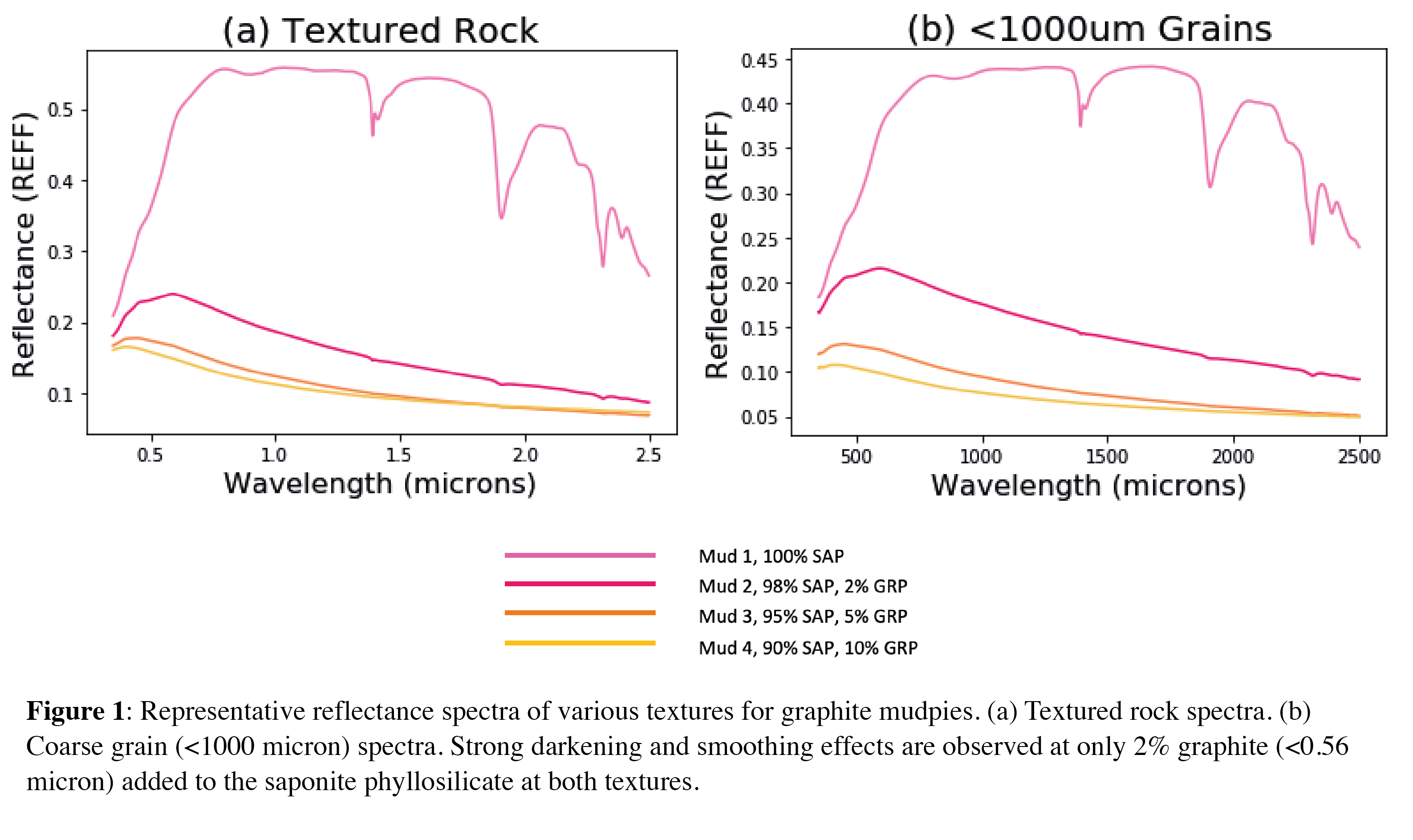
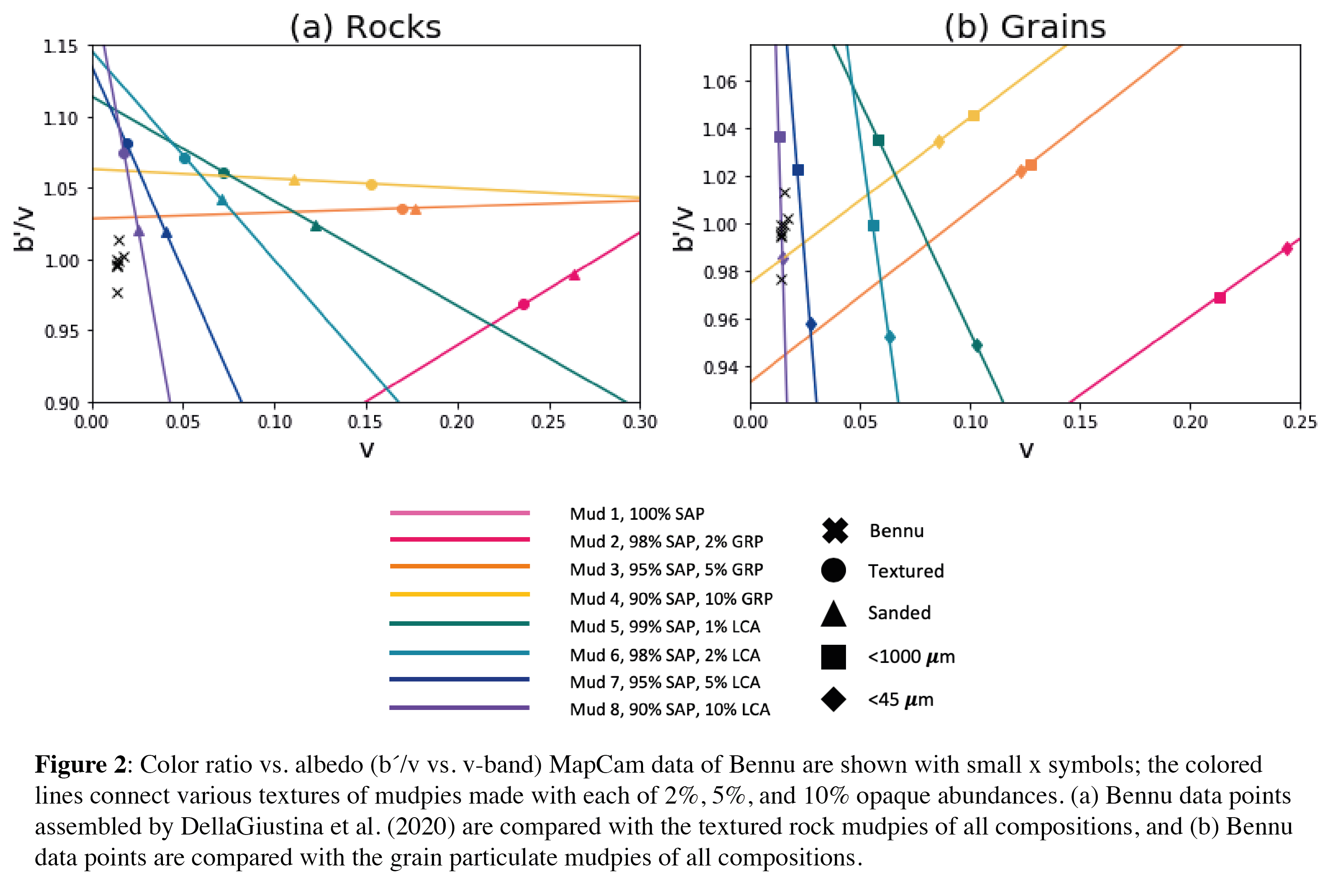
How to cite: Sen, A., Clark, B. E., Cloutis, E. A., Hendrix, A. R., DellaGiustina, D. N., Applin, D. M., Connell, S., Parkinson, A., and Ferrone, S.: Color Effects of Textural Variations on Bennu: Comparison of Analog Laboratory Mixtures with OSIRIS-REx Data, Europlanet Science Congress 2020, online, 21 Sep–9 Oct 2020, EPSC2020-137, https://doi.org/10.5194/epsc2020-137, 2020.
Introduction: Exogenous material has been reported on asteroids (101955) Bennu and (162173) Ryugu. The albedo, color, and spectra of six bright boulders on Bennu show that they are distinct from the rest of Bennu’s comparatively dark surface and are likely basaltic material from asteroid (4) Vesta (DellaGiustina et al. 2019; 2020). Bright boulders identified on asteroid (162173) Ryugu show absorptions near 1 µm but not near 2 µm, suggesting olivine-rich anhydrous silicates (Tatsumi et al., 2019; 2020).
Methods: In this work, we used images of Bennu obtained by the MapCam and PolyCam instruments (Rizk et al. 2018; Golish et al. 2020) on NASA’s OSIRIS-REx spacecraft (Lauretta et al. 2017) to search for more potentially exogeneous material on the surface of Bennu.
Results: We identified approximately 50 bright boulders on Bennu with significant x-band (0.85 µm) absorptions, including the six bright boulders previously described in DellaGiustina et al. (2020). These bright boulders are distributed across Bennu’s surface, concentrated in terrains with larger than average particle size. The boulders exhibit three main morphologies (homogeneous, heterogenous, and breccia) and three spectral types (reflectance peak at 0.55 µm, flat, and reflectance peak at 0.7 µm). There is some correlation between the morphology and the spectra. More specifically, three of the four boulders with reflectance peaks at 0.55 µm are in the breccia category and one is in the heterogeneous category, whereas all the boulders with reflectance peaking at 0.7 µm fall in the homogeneous and heterogenous categories. Bright boulders with reflectance peaking at 0.55 µm have lower normal albedo than the other two spectral groups, suggesting a different composition and possibly a different origin. An initial comparison with Ryugu (Tatsumi et al. 2019) indicates that Bennu is more abundant in possible exogeneous material.
Discussion: Further analysis of MapCam and PolyCam images has revealed a wider diversity of potentially exogenous lithologies on Bennu, expanding on the findings of DellaGiustina et al. (2020). We continue our study of this diversity of material on Bennu’s surface to constrain the asteroid’s origin, evolution, and collisional history (e.g., Ballouz et al. 2020).
References: DellaGiustina D. et al. (2019) Nat. Astron. 3, 341-351. DellaGiustina D. et al. (2020) Nat. Astron, in revision. Lauretta D. S. et al. (2017) Space Sci. Rev. 212, 925–984. Tatsumi E. et al. (2019) LPI Contribution No. 2132, id.1753. Rizk B. et al. (2018) Space Sci. Rev. 214, 26. Golish D.R. et al. (2020) Space Sci. Rev. 216, 12. Ballouz R.-L. et al. 2020, EPSC abstract.
How to cite: Campins, H., Tatsumi, E., Popescu, M., Rizos, J., Simon, A., Kaplan, H., deLeon, J., Licandro, J., DellaGiustina, D., and Lauretta, D.: Search for Candidate Exogenous Material on Bennu using MapCam and PolyCam Images, Europlanet Science Congress 2020, online, 21 Sep–9 Oct 2020, EPSC2020-472, https://doi.org/10.5194/epsc2020-472, 2020.
Abstract: Thermally driven fracture processes, such as thermal fatigue, have been hypothesized to drive rock breakdown and regolith production on asteroid surfaces [e.g., 1-7]. Thermal cycling induces mechanical stresses in rocks that drive the propagation of microcracks, which may grow into larger-scale features. This can drive the development of morphological signatures such as surface fracturing and disaggregation, and through-going fractures that split boulders apart. The nature and rate of boulder breakdown is controlled by rock composition, as well as the rotation period and solar distance of the body, suggesting its signature varies widely across the diverse asteroid population. Understanding how the process operates is critical to characterizing their surface properties and evolution.
Images from the Origins, Spectral Interpretation, Resource Identification, and Security–Regolith Explorer (OSIRIS-REx) spacecraft of the surface of Bennu provide the opportunity to search for in situ evidence of thermal breakdown over a wide range of scales. Recent works by the authors [7-9] show observations of boulder morphologies consistent with terrestrial observations [e.g., 10] and models of fatigue-driven boulder exfoliation [e.g., 11], i.e., the flaking of thin layers or shells of material from boulder surfaces. Relating these observations to thermally induced stress fields in phyllosilicate boulders reveals that such features develop via the propagation of surface-parallel fractures during periods of day when boulder surfaces are heating. The magnitude of these stress fields ranges from ~0.3 to 3 MPa for boulders up to 6 m in diameter, which is comparable to the tensile strengths of terrestrial phyllosilicate rocks (e.g., serpentinite) and sufficient to drive subcritical crack growth (thermal fatigue). The thickness of resulting exfoliation layers predicted by the model ranges from ~1 mm to 10 cm, which is consistent with terrestrial observations of exfoliation cracks [10] and with the thicknesses of exfoliation layers observed on Bennu’s boulders [9].
Further, we explore how boulder exfoliation may lead to the ejection of particles observed at Bennu’s surface [9] in an analogous manner to mobilization of rock fragments during large-scale, terrestrial dome exfoliation events [12]. We have observed particle ejection events from Bennu’s surface repeatedly since first entering orbit in January 2019. Observed particles range in size from <1 to 10 cm [7], consistent with our predictions for exfoliation. We quantified the available thermal strain energy in boulders beyond what is needed to propagate cracks and converted it to kinetic energy to constrain the speed of ejected particles. We find particles may be ejected with speeds up to ~2 m/s for boulders smaller than or equal to 6 m in diameter, which is comparable to the maximum observed particle speed of 3.3 m/s [7]. These results suggest that fatigue-driven exfoliation is a viable mechanism for producing or contributing to the activity observed at Bennu.
Acknowledgements: This material is based upon work supported by NASA under Contract NNM10AA11C issued through the New Frontiers Program, and under Contract NNH17ZDA001N-ORPSP through the Participating Scientist Program. We are grateful to the entire OSIRIS-REx Team for their hard work in making the encounter with Bennu possible.
References: [1] Molaro, J.L., et al., 2017. Icarus 294, 247-261. [2] El-Mir, C., et al., 2019. Icarus, 333, 356-370. [3] Hazeli, K., et al., 2018. Icarus, 304, 172-182. [4] Jewitt and Li, 2010. The Astronomical J., 140(5), p.1519. [5] Delbo, M. et al., 2014. Nature 508, 233–236. [6] Graves, K. J., et al., 2019. Icarus, 10.1016/j.icarus.2019.01.003. [7] Lauretta, D.S., Hergenrother, C.W., et al., 2019. Science, 366(6470). [8] Molaro, J.L., et al., 2020. Nat. Commun., 11(1), 1-11. [9] Molaro, J.L., et al., in review with JGR: Planets. [10] Martel, S.J., 2017. J. Structural Geol., 94, 68-86. [11] Holzhausen, G. R. (1989), Eng. Geol., 27(1-4), 225–278, 10.1016/0013-7952(89)90035-5. [12] Collins, B.D., et al., 2018. Nat. Commun., 9(1), 1-12.
How to cite: Molaro, J., Hergenrother, C., Chesley, S., Hanna, R., Haberle, C., Ballouz, R., Schwartz, S., Bottke, W., Walsh, K., Campins, H., and Lauretta, D.: Fatigue-driven boulder exfoliation as a driving mechanism for Bennu’s activity, Europlanet Science Congress 2020, online, 21 Sep–9 Oct 2020, EPSC2020-159, https://doi.org/10.5194/epsc2020-159, 2020.
Introduction: The flyby observations of 2014 MU69 (also known as Arrokoth) by the New Horizons spacecraft in 2019 showed that Arrakoth possesses a bilobate shape with unique surface morphologies [e.g., 1-3]. Arrokoth is likely to consist of an icy and porous structure [1]. High-resolution images captured a circular depression, Maryland. This ~7-km-diameter circular feature may be developed by a meteoroid impact process [1,3]. Assuming that Maryland is geologically younger than Arrokoth’s bilobate shape, here, we investigate the structural condition of Arrokoth, focusing on its neck.
We combine two models to analyze the neck’s structural sensitivity during the formation of Maryland. The first model computes the crater formation condition by using impact scaling relationships (Model I), while the second model characterizes the structural and dynamics conditions (Model II). To model Arrokoth’s shape [4], we assume that this body consists of a triaxial ellipsoid with a size of 22 km x 20 km x 7 km and a sphere with an equivalent radius of 6.3 km [4]. Below is the summary of these models.
Model I applies the pi-scaling relationships [5] to compute the Maryland formation condition on the small lobe. We define two end-member target materials. End-member A consists of a porous sand material [6] in the gravity regime and an icy, porous material [7] in the strength regime. End-member B is characterized by a water-ice material [8] in the gravity regime and an icy, porous material [7] in the strength regime.
Model II consists of two parts. The first part calculates the minimum level of the cohesive strength that the neck can avoid structure failure by the Maryland impact. The structural failure condition is calculated based on the Mohr-Coulomb yield criterion with an angle of friction of [9]. Impact driven loadings are computed with the assumptions of a zero-obliquity impact and zero momentum transfer, although these conditions may likely be different [e.g., 10, 11].
We integrate these models to compute the Maryland formation condition and determine the minimum cohesive strength of the neck, given the size of Maryland on Arrokoth.
Results: Figures 1 illustrates the bulk cohesive strength for the neck to resist structural failure. The cohesive strength needs to be higher than a few kPa, depending on material and structural conditions. It increases with the bulk density because the internal stress directly depends on the bulk density. The results imply that the predicted bulk cohesive strength for Arrokoth is higher than the typical values of the bulk cohesive strengths of small bodies. Small bodies observed at high resolutions were predicted to have bulk cohesive strengths of ~300 Pa [13, 14], except that there are a few rubble pile bodies having bulk cohesive strengths up to 1 kPa [15]. The Deep Impact ejecta also implied that the bulk cohesive strength of the nucleus of comet 9P/Tempel 1 might be less than~340 Pa [16]*. Also, ice rubbles may have a cohesive strength of ~1 kPa [17].
Discussion: Our analysis showed that Arrokoth needs much higher bulk cohesive strength than observed rubble pile small bodies. This discrepancy leads to two explanations. The first explanation is that Arrokoth has a high cohesive strength to resist structural failure during the Maryland formation. While this explanation may be plausible (depending on its structural condition), it is not supported by recent reports. If this is the case, it is necessary to review the mechanisms of cohesion. The second explanation is that the Maryland formation broke the neck’s structure. In this case, the neck lost mechanical strength. The two lobes could move freely, reaching a new stable shape configuration [14] while avoiding a complete separation (i.e., they fly away). Arrokoth needs a specific energy level to reach the current shape configuration at which the small lobe rests along the longest axis of the large lobe [18]. This condition constraints the relationships between the shape and the bulk density (Figure 2). Considering the current spin, we obtain that Arrokoth’s bulk density is between 300 kg/m3 and 500 kg/m3, which is consistent with [19] and the bulk density of the nucleus of 67P [20, 21].
*We note that [16] obtained an upper limit of the effective strength as 10 kPa, leading to a bulk cohesive strength of this nucleus less than ~340 Pa.
Acknowledgments: M.H. thanks support from NASA/SSW (NNH17ZDA001N/80NSSC19K0548). A.J.T. is supported by NESSF (80NSSC18K1265). M.H. and D.B. are also supported by Auburn University/Intramural Grant Program. This paper was published in the ApJL. Also, this work was originally planned to be presented at LPSC, which was canceled due to COVID-19.
References:
[1] Stern et al. (2019), Science, 364, eaaw9771, [2] White et al. (2019), AGU, P42C-01, [3] Singer et al. (2019), AGU, P331-3535, [4] Porter et al. (2019), AGU, P42C-02, [5] Holsapple (1993), Annual Review of Earth Planetary Science, 21, 333, [6] Wünnemann et al. (2006), Icarus, 180, 514, [7] Arakawa and Yasui (2011), Icarus, 216, 1, [8] Kraus et al. (2011), Icarus, 214, 724, [9] Lambe and Whitman (1969), Soil Mechanics, [10] Melosh (1989), Impact cratering: A geologic process, [11] Holsapple and Housen (2012), Icarus, 214, 161, [12] Johnson et al. (2016), GRL, 42, 10,068, [13] Hirabayashi et al. (2014), ApJL, 789, L2, [14] Hirabayashi et al. (2016), Nature, 534, 352, [15] Polisook et al. (2006), Icarus, 267, 243, [16] Richardson et al. (2007), Icarus, 190, 357, [17] Ettema and Urroz (1989), Cold Regions Science and Technology, 16, 237, [18] Scheeres (2007), Icarus, 189, 370, [19] Keane et al. (2019), AGU, P42C-03, [20] Sierks et al. (2015), Science, 347, aaa1044, [21] Thomas et al. (2015), Science, 347, aaa0440.
How to cite: Hirabayashi, M., Trowbridge, A., and Bodewits, D.: The mysterious location of Maryland on 2014 MU69 and the reconfiguration of its bilobate shape, Europlanet Science Congress 2020, online, 21 Sep–9 Oct 2020, EPSC2020-321, https://doi.org/10.5194/epsc2020-321, 2020.
Introduction
Data returned from spacecraft missions to asteroids show the ubiquity of rough surfaces covered in coarse grains. Recent data from Hayabusa-2 at Ryugu and OSIRIS-REx at Bennu show surfaces that are rubbled and coarse [1,2], with regolith grain sizes estimated to range from mm to dm [3]. As such surfaces appear to be common on small asteroids, understanding how coarse grains behave in asteroid-like environments can shed light on the observed topography, activity, and impact response of these bodies.
In the work presented here, we investigate impacts into coarse grain targets at speed ranges from 0.1 to 2 m/s. These speed ranges apply to both natural and spacecraft-induced processes. Indeed, recaptured secondary ejecta, which has speeds below the body’s escape speed, is expected to impact the surface of a small asteroid at speeds around or below 25 cm/s (e.g. 26 cm/s for Ryugu). In addition, recent and current missions to asteroids have interacted or plan to interact with their coarse-grain surfaces at speeds around or below 20 cm/s in order to land hardware or collect surface samples. For example, Hayabusa 2’s Mobile Asteroid Surface Scout (MASCOT) lander touched down Ryugu’s surface at a speed of 17 cm/s in October 2018 [4]. Understanding impact processes and surface responses at these low speeds can provide much-needed context for surface interaction activities at these small bodies and thus increase the mission science return.
1. Experiment Setup
Figure 1: Frame sequences of impacts at 1.3 m/s into mm-sized grains (top) and at 60 cm/s into cm-sized grains (bottom).
Experiment Hardware: The impact data presented here were collected with the Physics of Regolith Impacts in Microgravity Experiment - Drop tower (PRIME-D). Inside a vacuum box, a projectile is launched into a regolith sample tray of dimensions 13×13×3 cm3 while the whole assembly is under free-fall. A camera records the impacts with 1020p resolution at 500 fps.
Target Material: We used asteroid regolith simulant to prepare target material grains [5] and focused on grains in the mm and cm range.
Projectiles: The projectiles used were Teflon, quartz (glass), and brass spheres of 1 cm in diameter.
Experiment Runs: We performed 86 experiment runs (Figure 1). The experiment plan we followed aimed at including three impacts for each combination of target material, projectile density, and impact velocity range. The three impacts for each combination allow for the computation of error bars on the impact outcome results.
Figure 2: Results from low-velocity impacts into coarse grain targets. Small symbols, dashed line: mm-sized grain target; Large, full: cm; Green: mixed; Red: fine JSC-1 grains [6]. (left) Mean ejecta velocity; (middle) COR; (right) Ejecta mass estimation (0: none; 1: the ejected mass is much lower; 2: on the same order; 3: much larger than the projectile mass.
2. Data Analysis and Results
The main results of our data analysis can be summarized as follows:
Impact Outcomes Similarly to impacts into fine grains [6], we observed a variety of impact outcomes, including projectile rebound off the target surface after impact (61 % of the observed impacts). We also observed a new outcome which was not seen for fine grain target: rolling of the projectile at the surface of the target after initial impact.
Ejecta Speeds The measurement of ejecta speeds showed the limitations of our experimental setup for impact speeds below about 40 cm/s. For higher impact speeds, we were able to scale the ejecta speeds the the projectile (Dp) and target grain sizes (dp), as well as the impact speed (vi).
Ejecta Masses Estimations for the ejected mass upon impact showed a simple scaling between the impact energy and the mass of the lifted material as long as no ejecta curtain is created. This trend is reversed for the lifting of ejecta blankets, indicating that the target material cohesion becomes apparent for larger impact energies and that larger grains present a looser surface than smaller ones.
Coefficient of Restitution (COR) For impacts leading to rebound and rolling of the projectile, we measured the associated COR. Our data set showed a relatively low dependence of the COR on the target grain size.
Projectile Penetration Depth For a number of impacts, we also measured the maximum penetration depth of the projectile into the target material. We find that the larger the grain size in a regolith bed, the lower the penetration depth.
3. Comparing to Spacecraft Data
Hayabusa 2’s MASCOT landing on the surface of Ryugu in October 2018 [4] presents a great opportunity to place our experimental findings in context with actual spacecraft data. While MASCOT is one order of magnitude larger than our projectiles and its impact onto the surface was oblique, a number of other parameters were similar to the ones explored in our experiment plan. In particular, the impact speed of 17 cm/s is in the low range investigated here and the size ratio between MASCOT and the boulders/coarse grains of Ryugu’s surface ranges from 0.1 to 1 cm, just like in our experiments. We will present a comparison between the CORs measured for the MASCOT rebounds and our experimental results. We will also compare our measured data to numerical simulations of the MASCOT landing.
References
[1] Lauretta, et al., Nature, 568(7750):55–60, 2019a.
[2] Watanabe, et al., Science, 364(6437):268–272, 2019.
[3]Sugita, et al., Science, 364(6437):eaaw0422, 2019.
[4]Scholten, et al., Astronomy & Astrophysics, 632:L3, 2019.
[5]Covey, et al., Earth & Space Conference, pages 11–15, 2016.
[6]Brisset, et al., Progress in Earth and Planetary Science, 5(1):73, 2018.
How to cite: Brisset, J., Cox, C., Anderson, S., Hatchitt, J., Madison, A., Mendonca, M., Partida, A., and Remie, D.: Regolith behavior under asteroid-level gravity conditions: low-velocity impacts into mm- and cm-sized grains, Europlanet Science Congress 2020, online, 21 Sep–9 Oct 2020, EPSC2020-476, https://doi.org/10.5194/epsc2020-476, 2020.
Introduction:
The OSIRIS-REx mission’s observation campaigns [1] using the PolyCam instrument, part of the OSIRIS-REx Camera Suite (OCAMS) [2 3], have returned images of the surface of near-Earth asteroid (NEA) (101955) Bennu. These unprecedented-resolution images resolved cavities on Bennu’s boulders (Fig. 1) that are near-circular in shape and have diameters ranging from 5 cm to 5 m. We made hundreds of measurements of these cavities in image and laser altimeter data and found more than 100 boulders that exhibit at least one on their surface (Fig. 1).
The most likely mechanism for the creation of these cavities is impacts. However, it is unclear whether these “mini-craters” were formed during Bennu’s residence in the main asteroid belt, or if they were formed more recently, after Bennu became a near-Earth asteroid (NEA). We use our observations of mini-craters to derive the strength of solid C-type objects against impacts. Our results have implications for Bennu’s history in the main-belt and in near-Earth space.
The Strength of Monolithic C-type Objects:
The strength of asteroids against collisions is crucial for understanding the surface evolution of airless planetary bodes, the dynamical evolution of asteroids throughout Solar System history, and the incorporation of planetesimals into planets [4,5].
Laboratory data on centimeter-scale meteorites have been extrapolated and buttressed with numerical simulations and analytic formalisms to derive the cratering threshold at the asteroid scale [6–8]. However, thus far it has not been possible to directly assess the strength of the boulders that constitute the building blocks of a rubble-pile asteroid. Apollo lunar rocks and spacecraft missions to near-Earth asteroids indicate only two modes of impact-induced breakdown of boulders: 1) abrasion by micro-meteorites (sand-blasting), and 2) catastrophic rupture by a single large impact [9–11]. Widespread cratering on boulders has not been observed heretofore.
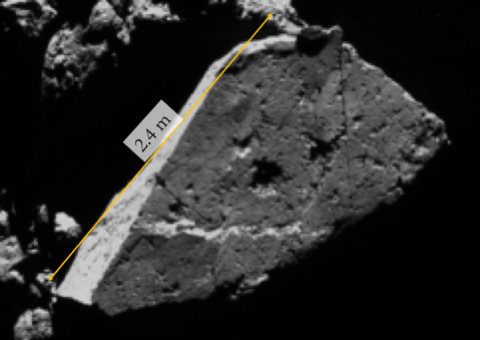
Figure 1: Centimeter-scale impact features on the sur-face of a boulder (image 20190703T044506S720_pol, taken July 3, 2019, by the OCAMS PolyCam imager; 1 cm/pixel).
We developed a new method to derive the cratering efficiency and the disruption threshold of C-type objects by combining scaling laws and observations of craters on C-type boulders and asteroids [12–14]. We postulate that the largest crater on a boulder of a given size signifies an impact energy close to that required for disrupting that boulder. This type of analysis has been previously done for the study of the largest craters on planetary bodies larger than tens of kilometers using scaling laws [6] and laboratory experiments [15]. Here, we extend that analysis to objects of smaller size.
We find that the crater to impactor size ratio on C-type objects is ~ 15, and that the collisional disruption of 1-m radius boulders on the surface of Bennu is efficient in the main belt (~ 1 Myr) but effectively ceases in near-Earth space as their collisional lifetime (~50 Myr) becomes greater than the dynamical lifetime of NEAs (<10 Myr) [16].
Towards a mini-crater clock for NEA surfaces:
Detailed analysis of the surface density of mini-craters on Bennu’s boulders may provide a new way to determine relative ages of different regions of the surface. This can be used as a basis of comparison or calibration for alternative approaches to chronology, such as assessments of the small crater population on Bennu’s surface [12] or space-weathering on Bennu’s surface [17]. Our findings may be validated by analyzing the cosmic ray exposure ages of the returned sample.
Acknowledgements
This work was supported in part by NASA grant NNX15AH90G awarded by the Solar System Workings program. S.R.S. acknowledges support from NASA Grant no. 80NSSC18K0226 as part of the OSIRIS-REx Participating Scientist Program. This material is based upon work supported by NASA under Contract NNM10AA11C issued through the New Frontiers Program. P.M. acknowledges support from the Centre National d’Études Spatiales and from the Academies of Excellence on Complex Systems and Space, Environment, Risk and Resilience of the Initiative d’EXcellence “Joint, Excellent, and Dynamic Initiative” (IDEX JEDI) of the Université Côte d’Azur. We are grateful to the entire OSIRIS-REx team for making the encounter with Bennu possible.
References
[1] Lauretta et al. (2017) Space Science Reviews 212, 925.[2] Rizk, B. et al. (2018) Space Science Reviews, 214, 26. [3] Golish, D.R. et al. (2020) Space Sci. Rev. 216, 12. [4] Michel, P. et al. (2001) Science, 294, 1696. [5] Bottke, W.F. et al. (2005) Icarus, 179, 63. [6] Holsapple, K.A. (1993) AREAP, 21, 333. [7] Benz, W., & Asphaug, E. (1994). Icarus, 107, 98. [8] Jutzi, M. et al. (2010) Icarus, 207, 54. [9] Hörz, F., et al. (1975) The Moon, 235. [10] Cheng, A.F. (2002) Asteroids III, University of Arizona Press, 351-366. [11] Nakamura, A.M. et al. (2008) Earth, Planets, and Space, 60, 7. [12] Walsh, K.J. et al. (2019) Nature Geoscience, 12, 242. [13] Sugita, S. et al. (2019) Science, 364, 252. [14] Veverka, J. et al. (1997) Science, 278, 2109. [15] Leliwa-Kopystyński, J. et al. (2008) Icarus, 195, 817. [16] Michel, P., & Delbo, M. (2011) Icarus, 209, 520. [17] Trang, D. et al. (2019) LPSC L, Abstract #2172.[1] Lauretta et al. (2017) Space Science Reviews 212, 925
How to cite: Ballouz, R.-L., Walsh, K., Bottke, W., DellaGiustina, D., Al Asad, M., Michel, P., Avdellidou, C., Delbo, M., Jawin, E., Asphaug, E., Barnouin, O., Bennett, C., Bierhaus, E., Connolly, H., Daly, M., Daly, T., Golish, D., Molaro, J., Pajola, M., and Rizk, B. and the OSIRIS-REx mini-crater team: Craters on (101955) Bennu’s boulders, Europlanet Science Congress 2020, online, 21 Sep–9 Oct 2020, EPSC2020-502, https://doi.org/10.5194/epsc2020-502, 2020.
Hypervelocity impacts on carbonaceous asteroid simulants: comparison with observations
C. Avdellidou(1,2), Marco Delbo(1), Cody Schultz(3), Mark Price(2), Alice DiDonna(4), Bart Harthong(4), Mike Cole(2),Daniel Britt(3), Robert Peyroux(4)
contact:
Introduction
Two on-going sample return space missions, Hayabusa2 and OSIRIS-REx are orbiting and characterising two near-Earth asteroids, (162173) Ryugu and (101955) Bennu respectively. Initial ground-based observations and mission data indicate that the composition of these small objects is similar to the CM or CI meteorites (1-4). However, their thermo-mechanical properties appear to be different (5,6). This is expected since Earth's atmosphere filters out the weakest materials and thus we do not have them in our meteoritic collections. How does this weak materials respond to impacts? What type of regolith is produced during micrometeoroid bombardment? Will we expect to find exogenous materials embedded on the weak surfaces of Bennu and Ryugu?
Materials
In our work we used as targets to hypervelocity impact experiments, asteroid analogue materials with mineralogy similar to the CM meteorites. Specifically, the CM2 regolith simulant is a close mineralogical match to the Murchison CM2 carbonaceous chondrite meteorite Since one of the aims of the project was to examine qualitatively the produced regolith after impact events, we used as inclusions glass beads for an easier examination. The samples were produced and casted at the Exolith Lab of the University of central Florida. Samples were also mechanically tested at the 3SR Lab in Grenoble, where the compressive stress and tensile strength were measured. In addition we measured the thermal conductivity of the samples.
Experiments
In order to study the response of the CM-like asteroid analogue material to collisions with small projectiles, at typical impact speeds occurring in the asteroid Main Belt, we performed a series of laboratory hypervelocity impact experiments. We used the facilities of the Impact Lab of the University of Kent in the UK. main instrument used here is a 2-stage light-gas gun (LGG), which can achieve speeds up to 7.5 km/s. Targets were the squared blocks of CM analogues with dimensions 9.5 cm x 9.5 cm and 4.4 cm thickness, while as projectile we used stainless steel of different diameters. In these experiments we measured the depth and diameter of the craters, the quality of the ejecta and the state of the inclusions. In particular we wanted to test a part of the hypothesis that on materials with inclusions, impacts produce mainly ``multimineralic" fragments, whereas thermal cracking, as a slower process can produce fragments of single composition. After the impact experiments the roughness of the impacted samples was also calculated.
Comparison with spacecraft observations
First of all we compare the materials we produced with the inferred data from the space mission observations. Furthermore, we compare our laboratory impact results with impact observations of the same scale on the boulders of asteroid Bennu (mini-craters,7).
Combining the mechanical properties of the asteroid simulants and the impact results, we predict that the impact shockwave dissipates very rapidly in such a soft material, therefore one would expect to see also fragments with one unique composition.
Fig.1 Comparison between the surface of Ryugu (left) and our post-impact asteroid simulant (right).
Acknowledgements
This work was supported by the BONUS QUALITE RECHERCHE Lagrange (BQR) 2017; by the French National Research Agency under the project ``Investissements d’Avenir" UCAJEDI with the reference number ANR-15-IDEX-01; by the Programme National de Planetologie (PNP) of CNRS/INSU, co-funded by CNES.
References
[1] Grott et al. Nature Astronomy, 3, p. 971-976, 2019
[2] DellaGiustina, Emery et al., Nature Astronomy, 3, 341, 2019
[3] Kitazato et al., Science, 364, 272, 2019
[4] Moskovitz et al., Icarus, 224, 24, 2013
[5] Perna et al., A&A, 599, L1, 2017
[6] LeCorre et al., MNRAS, 475, 614, 2018
[7] Ballouz et al. Nature (under revision) 2020
How to cite: Avdellidou, C., Delbo, M., Schultz, C., Price, M., DiDonna, A., Harthong, B., Britt, D., Cole, M., and Peyroux, R.: Hypervelocity impacts on carbonaceous asteroid simulants: comparison with observations, Europlanet Science Congress 2020, online, 21 Sep–9 Oct 2020, EPSC2020-762, https://doi.org/10.5194/epsc2020-762, 2020.
- 1London Metropolitan University, School of Human Sciences, United Kingdom of Great Britain and Northern Ireland (j.tandy@londonmet.ac.uk)
- 2School of Physical Sciences, Ingram Building, University of Kent, Canterbury, CT2 7NH
- 3Laboratoire Lagrange, Observatoire de la Côte d’Azur, UCA, France
Introduction
The self-luminous plume (or ‘flash’) resulting from hypervelocity impacts onto planetary bodies are readily observed (even for relatively small-scale impacts) [1-3], despite the radiative decay of the impact-induced emission being relatively short-lived. The replication and measurement of such impact events in the laboratory is critical to gain a deeper understanding of the wavelength dependence and dynamic behaviour of impact flashes from icy bodies and contribute towards a thorough assessment of the physical and chemical processes these frozen systems are exposed to. The temporal evolution of impact flashes are often measured in the laboratory using photodetectors, e.g. [4-6] or high-speed cameras, e.g. [6-9], and reveal multiple phases of the radiating ejecta. The behaviour of emission during these phases are dependent upon several parameters including target composition and porosity, projectile material, impact speed and angle [6,8,10]. This study examined the wavelength dependence and temporal variation of the hypervelocity impact flash from CO2 ice targets using a variety of projectiles.
Experimental
The Kent two-stage light-gas gun was used to horizontally accelerate projectiles (Table 1) into CO2 ice targets compressed into 100 mm diameter, stainless steel cans with their surface aligned at 90o to the shot line. Targets were stored at approximately -140 oC prior to impact to prevent significant CO2 ice sublimation. Experiments used impact speeds between 4.6 and 5.0 km/s (Table 1), with the target chamber evacuated to ~50 mbar during each shot.
Table 1 – Experimental parameters for impact flash measurements
The impact flash decay was monitored across ten spectral bands (between 355 nm and 950 nm) using an array of identical photodiodes, with different optical/IR band-pass filters. Photodiodes were placed slightly below the shot line within the target chamber, approximately 650 mm from target surface, with a field of view of approximately 25 cm at the point of impact. The resulting emission intensity data have a time resolution of 1.0 µs and were adjusted for the quantum efficiency of the photodiodes and normalised according to the transmission efficiency at the central wavelength of each band-pass filter. Photographs of the impact flash were recorded through a window in the target chamber approximately 1.1 m and 15˚ from the projectile shot line using a ‘High Speed Camera Company’ FPS2000 digital video camera utilising a 50 mm Nikon f1.2 lens with a resolution of 1024 x 360. The camera was operated continuously at 2800 frames/s and selected frames extracted post-shot.
Results and Conclusions
Figure 1 illustrates the variation in flash decay profile observed for each photodiode using the 3.0 mm diameter glass projectile, indicating a wavelength dependence previously observed for aluminium impacts onto ices [11]. Additional variations between photodiode channels were detected for all other projectile materials, with the largest differences observed using aluminium (shown in Figure 2) for the 440 nm photodiode channel. The high-speed photographs in Figure 3 also show the significant difference in impact flash colour and shape when using the aluminium projectile. The orange-yellow colour originates from strong zinc atomic emission (~ 6% Zn in Al-7075) at 624 nm, 636 nm and 648 nm within the ejecta plume [12].
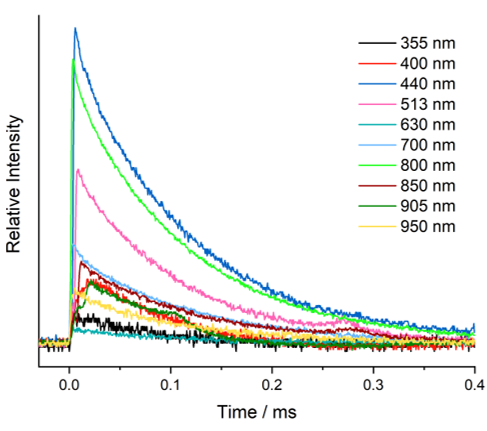
Figure 1 – Flash decay measurements from a 3.0 mm diameter sodalime glass projectile impacting CO2 ice at 4.73 km/s.
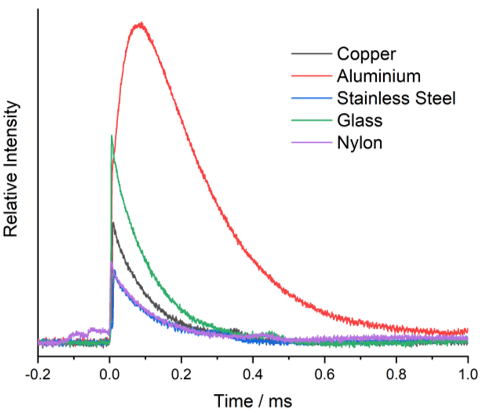
Figure 2 – A comparison of the impact emission profile for the 440 nm photodiode channel using different projectile materials.
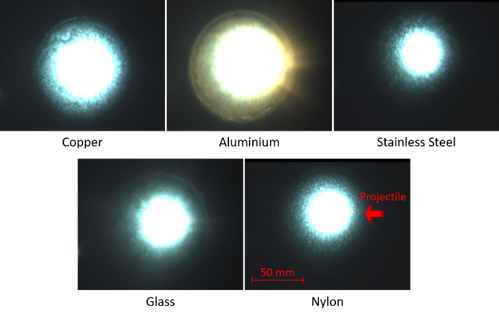
Figure 3 – A comparison of impact flash photographs using different projectile materials.
Analyses of the emission profiles for the 440 nm and 800 nm channels were used to calculate decay exponents (α) for each projectile material as described by Ernst and Schultz [13] and are shown in Figures 4 and 5. For projectiles other than aluminium, there is a good agreement in the calculated α values (< 0.035 difference), demonstrating a consistency in the behaviour of flash decay across the visible region. However, the α values for the aluminium projectile differ by 0.077, which may be due to influence from AlO emission within the 440 nm photodiode region [14].

Figure 4 – Decay curves and exponents (α) from the 440 nm photodiode data for each projectile material.
Figure 5 – Decay curves and exponents (α) from the 800 nm photodiode data for each projectile material.
These observations highlight the importance of using a broad range of parameters when replicating impact events in the laboratory and may provide a useful comparison for future observations of impact flashes on icy bodies.
Acknowledgements
MCP, PJW, MJC and JT thank the STFC for funding assisting this work. LA acknowledges receipt of a University of Kent GTA Scholarship. CA thanks ESA Science Faculty grant for funding the detection instrument. The work of CA was supported by the French National Research Agency under the project “Investissements d’Avenir” UCAJEDI (ANR-15-IDEX-01).
References
[1] D.W. Dunham et al., 2000, 31st LPSC, #1547.
[2] B.M. Cudnik et al., 2003, Earth, Moon and Planets, 93, 145.
[3] M. Delcroix & R. Hueso. 2013, EPSC, #EPSC2013-812-1.
[4] M.J. Burchell et al., 1996, Icarus, 122, 359-365.
[5] H. Yafei et al., 2019, Int. J. Impact. Eng., 125, 173-179.
[6] C.M. Ernst & P.H. Schultz, 2007, Icarus, 190, 334-344.
[7] J.M. Mihaly et al. 2015, J. Appl. Mech. 82, 011004.
[8] P.H Schultz & C.A. Eberhardy, 2015, Icarus, 248, 448-462.
[9] J.D. Tandy et al., 2014, J. Appl. Phys., 116, 034901.
[10] J.A. Ang, 1990, Int. J. Impact Eng., 10, 23-33.
[11] J.D. Tandy et al., 2019, EPSC-DPS, 13, 2019-1897-1.
[12] NIST ASD Team et al., 2019, NIST Atomic Spectra Database (ver. 5.7.1), https://physics.nist.gov/asd.
[13] C.M. Ernst & P.H. Schultz, 2003, Lunar Planet. Sci. XXXIV. Abstract 2020.
[14] R.W.B. Pearse & A.G. Gaydon, 1976, The Identification of Molecular Spectra (4th ed.), Chapman and Hall, New York.
How to cite: Tandy, J., Price, M., Wozniakiewicz, P., Cole, M., Alesbrook, L., and Avdellidou, C.: The Effect of Projectile Material on the Impact Flash from Carbon Dioxide Ice, Europlanet Science Congress 2020, online, 21 Sep–9 Oct 2020, EPSC2020-144, https://doi.org/10.5194/epsc2020-144, 2020.
Please decide on your access
Please use the buttons below to download the presentation materials or to visit the external website where the presentation is linked. Regarding the external link, please note that Copernicus Meetings cannot accept any liability for the content and the website you will visit.
Forward to presentation link
You are going to open an external link to the presentation as indicated by the authors. Copernicus Meetings cannot accept any liability for the content and the website you will visit.
We are sorry, but presentations are only available for users who registered for the conference. Thank you.
